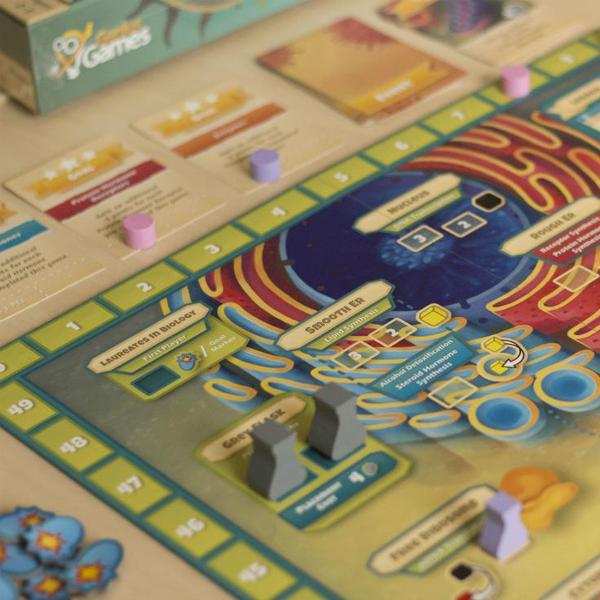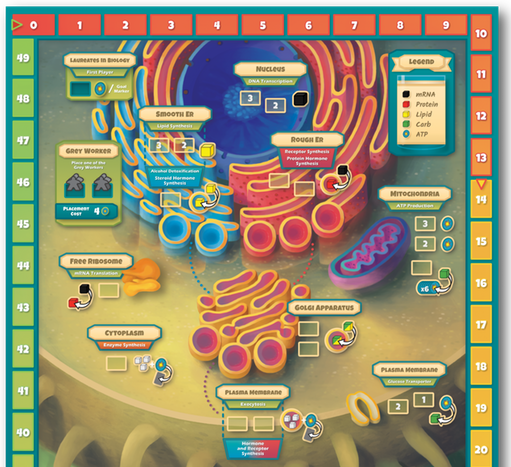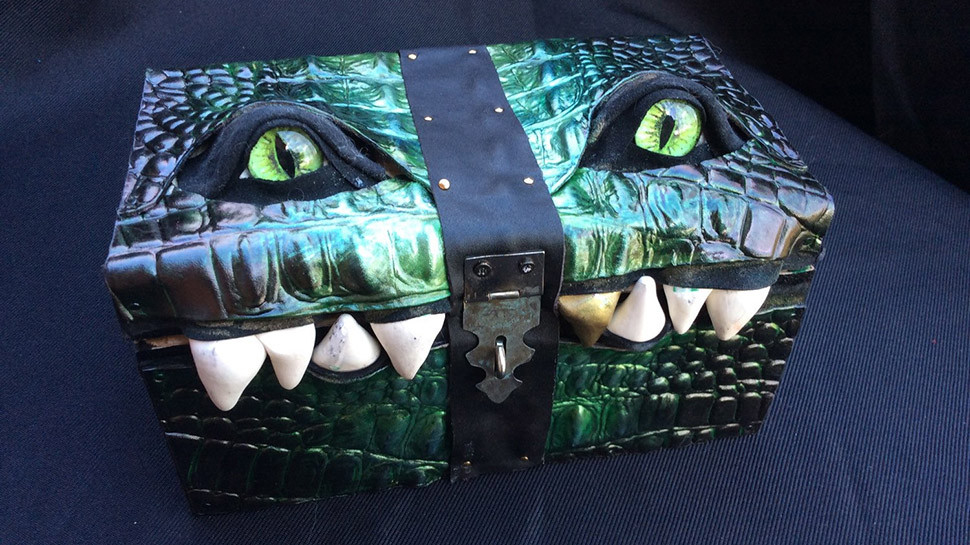As part of our November Spotlight on Cytosis, we strive to inform readers of little extra tidbits surrounding the game. Games are made by people, and one of those tidbits we enjoy is learning a little bit more about the people behind them. Some designers shy away from the public stage, while others enjoy being front and center.
In the case of Cytosis, there’s a bit of an art-imitating-life factor that borders on ironic. See, one of the most fundamental traits about a cell is that it never stops working. If a cell stops performing its inherent functions, it’ll die. It doesn’t take breaks or veers off to try something unrelated to its goals. Cells are programmed on the most basic levels imaginable to behave a certain way, and there’s little room for doing anything but continuing to do the work that’s being asked of it.
The same can largely be said of Cytosis designer and head of Genius Games John Coveyou. In addition to his emphasis on his non-gaming responsibilities of job and family, John is perpetually busy working on ensuring Genius Games is making reliable science-based products that are both fun and accurately presented. It makes for long days and little free time, but the results speak for themselves at this point.
That being said, much like the cell itself, it was quite challenging to get John to stop moving for a few minutes, if even to chat. Hence this Spotlight interview’s debut as we’ve already crossed over into December.
But why waste our respective cellular energies telling you about this when we can just show you instead? As brief as our time with John was, it’s hard to not get a little wrapped up in the level of excitement and zeal he has for designing and publishing games that revolve around the scientific world. In the short window we were able to manage, John expounds on how he approaches running Genius games and why he feels it’s an important distinction between making games that happen to teach something rather than an educational game that just happens to be fun. Enjoy!
Round One Questions
CR: What was your Gateway Game?
Actually my gateway games were simultaneously D&D and Monopoly. I know it sounds odd, but I have such incredible memories of playing both as a young boy!
CR: What was the last game you really enjoyed playing (besides Cytosis)?
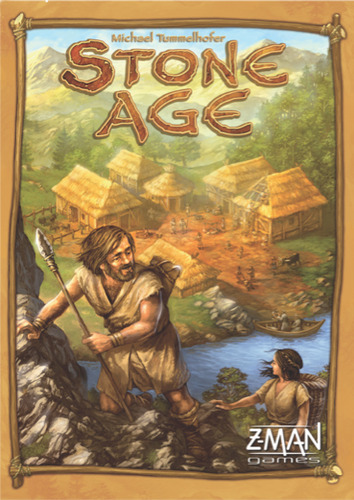 One game that I always come back to is Stone Age. I think it is one of the most elegant and easy to learn games, and yet the decision making and strategic options are incredibly deep.
One game that I always come back to is Stone Age. I think it is one of the most elegant and easy to learn games, and yet the decision making and strategic options are incredibly deep.
CR: How big is your game collection?
I’m always backing some cool board game on Kickstarter. I don’t currently have an exact number, but probably around 300 to 400. I can say that I’ve got several bookshelves of games in my basement, as well as an overflowing game shelf in my office.
CR: What is your favorite type of game to play?
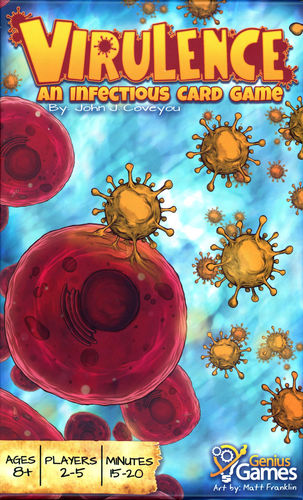 I really enjoy well-crafted light games like For Sale, Love Letter, and Virulence, but if I’ve got a bit more time I gravitate toward medium weight euro style games that provide a wide range of interesting decisions.
I really enjoy well-crafted light games like For Sale, Love Letter, and Virulence, but if I’ve got a bit more time I gravitate toward medium weight euro style games that provide a wide range of interesting decisions.
CR: How do you feel about Monopoly?
Well…I think it has a great deal of nostalgia surrounding it, and it does its job of creating memorable and intense experiences. And for it’s time, I would say it was a good game. All of these things are great! And let’s be honest: Parker Brothers certainly knows how to re-theme the heck out it. But I think it lacks in the quality of the decisions that it offers players.
On Cytosis
CR: Given the amount of activity in a biological cell, a worker placement game around that theme seems obvious in hindsight. How did the concept come about?
Turning a hard science concept into a game while staying accurate to the science is difficult – the restrictions that the science places on the game creates some interesting challenges. I found that worker placement allowed me to stay true to the science. Worker placement is also a very easy to introduce mechanic and provides all kinds of player interaction that’s not too confrontational. It’s a simple mechanic, yet it naturally provides interesting options for players right from the start.
Worker placement also completes resource production and management well, which is why its used in so many games that mimic cities, ala Lords of Waterdeep. And a city is commonly used to explain the overall functionality of the human cell. So it worked on many levels.
CR: Was there any facet of cell cytosis that you wanted to include in the game but didn’t due to issues of complexity, difficulty, etc.? If so, which?
Oh sure! Too many to count. The games play through the most basic overarching process that defines how a cell produces its most fundamental components, how it uses those fundamental components to function, and how it functions overall as a whole. And it’s highly accurate to that! The more minute details are left up to the players to research.
Finding the right balance for an educational game between being a teaching tool and still remaining principally a game can be quite tricky. How do you know you’ve found that balance during development?
It’s a tough balance. The core game mechanic for every one of my games always grows out of a scientific concept, but I create for gamers first. Throughout the development process, I’m extremely intentional about requesting feedback and critique from both gamers and scientists. I want a teacher to be able to pull it out in their classroom, but I also want the gamer to happily pull it out at their game night. I know I’ve found the desired balance if a science teacher starts giggling gleefully while I explain the rules and then decides then and there to add it to their curriculum, and if a gamer sits down and is genuinely engrossed by their strategic options.
CR: You’ve now done a couple games that take place on the cellular level. Science focus aside, what is it about that particular subject that appeals to Genius Games?
I think I was actually on a plane when I first put the Cytosis concepts onto paper. I knew I wanted a game that mimicked the internal process of human cells and the processes they go through because they are a foundational part of any study of biology. But I also think something as integral to the human experience as cells is inherently intriguing. I’m certainly astounded by the processes that take place in our cells every second of every day, and wanted to utilize my skillset to give other people an approachable way to interact with these intriguing and complex processes.
CR: Genius Games is renown for creating games with the intent of being as entertaining as they are educational. Was that the inspiration for that approach?
From the beginning I knew that I wanted to integrate two of my great loves – games and science. Don’t get me wrong, I love sci-fi themes or ancient world themes, but with my background in science and considering that there wasn’t anyone else creating hard science gamer games, it was pretty clear to me that hard science was the niche I should try to fill.
CR: Have you ever attempted to make a game about a particular field of science but was unable to for one reason or another?
Several years ago I started developing a game about Mendelian genetics. I’d get it developed to the point of being playable but just wasn’t happy with the core mechanic, so I’d tear it apart and start from scratch. I’ve torn that game apart and started fresh many times by now. I haven’t completely given up on that one, as the topic is so intriguing, but I did set it on the back burner for now. It would work, but it just wasn’t very fun. Someday I’ll get it back out and try again!
CR: What comes first to you when designing a game: the mechanics and enjoyment factor or the teaching elements? Or does it vary?
So I don’t actually design games to teach. I simply design them to be scientifically accurate. And that’s an important distinction. I don’t want to make educational game. I want to make hobby board games, and theme them very accurately about science topics that interest me.
I always begin with a science concept that is foundational to biology, chemistry, or physics, and is also particularly fascinating to me. After that, I work to find and / or craft a mechanic that will provide an exciting way to interact with whatever complex science concept or process it’s themed around. And I think that initially is the toughest part.
Throughout the rest of development, those two factors are constantly butting heads. In some regards, the science does restrict what I’m able to do with the mechanics, but in the end, I think those restrictions make the resulting game more unique, because I’ve had to get really creative to stay within the restrictions the science sets.
CR: Finally, tell us: what happens if you stack a bunch of Cytosis boxes together? It just seems like it’d be something to be cautious about…
It actually forms a fully functional ludological micro-organism. We did it one time, and it gained consciousness and turned on us. So we called in the National Guard to take it down.
I can assure you now that we will never stack too many boxes of Cytosis too close together anymore…
Cytosis does an excellent job showing players a lightweight worker placement game that also happens to detail many of the basic functions of a cell that we rarely think about, completely taking for granted the incredibly complex systems that are taking place on a microscopic level. The fact that you can read this means those cells are doing their job. It’s pretty incredible when you think about it.
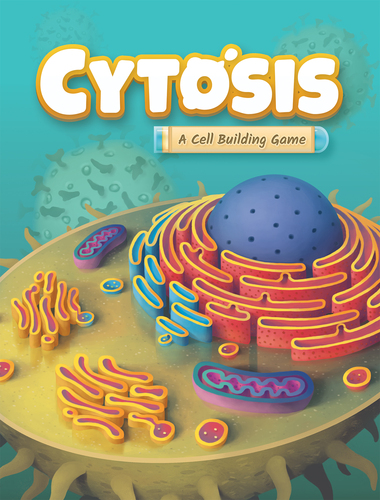
Given the time crunch, we’re going to make this one simple: we want one of you to have a copy of Cytosis. Because science is cool. And games about science should be championed. We don’t shrink you down and make you repeat A Fantastic Voyage or anything. We just want to share the love of learning. And since we can’t actually learn by osmosis, a game’s probably the next best thing, right? So let’s get to it!
Time For Some Active Transport
Photo Credits: Cytosis cover and photos by Genius Games; Box Monster by Etsy.

